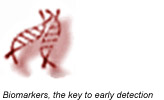
UCI Biomarker Detection Laboratory for
Early Detection Research Network (EDRN)
Early Detection Research Network (EDRN) Lay Abstract
Prostate cancer now affects one in five men in the U.S. It is diagnosed by examination of a biopsy sample of the prostate gland by a pathologist and treatment decisions such as the choice of surgery are usually not made without direct visualization of the presence of cancer by a pathologist. There are about one million such biopsy procedures in the U.S. every year. However about 1-200,000 are ambiguous owing to the absence of tumor but the presence of small changes such as atypical small acinar proliferations (ASAP) or proliferations within otherwise normal glands (PIN, prostate intraepithelial neoplasia) that are highly suspicious for cancer. Studies by the UCI/NCI SPECS project on prostate cancer have led to a new way to diagnosis the presence of prostate cancer in these ambiguous changes. Researchers of the UCI/NCI SPECS project observed that the tissue around a tumor called stroma has many altered gene activities that are caused by molecules secreted by the tumor cells. Indeed these studies revealed that 114 genes exhibited altered activity in stroma near tumor compared to normal stroma. These changes can be used as a “signature” to examine new samples to determine the “presence-of-tumor”. Such a test has many applications. Currently ambiguous cases are asked to return for a repeat biopsy in 3 to 12 months – an agonizing period for patients during which they receive no guidance and any tumor may continue to grow and spread. Thus, the new test would detect tumor 3 to 12 months prior to conventional practice. This will avoid repeated biopsy procedures. Patients who are positive by the new test may consider whether immediate medical treatment or neoadjuvant treatment is appropriate. In addition the ability to detect presence-of-tumor early will avoid the necessity of waiting to have a repeat biopsy procedure. Finally the genes that undergo altered activity reveal fundamental information about how tumors alter the cellular environment.
The National Cancer Institute (NCI) program called the Early Detection Research Network (ERDN) has agreed to support the continued development of the 114 gene signature for diagnosis of prostate cancer. Under this program, the 114 gene signature will undergo a series of studies designed to validate the accuracy and reliability. The gene signature will be applied to actual biopsies of consenting patients who have an ambiguous result for the first biopsy. Patients will be drawn from UCI, Northwestern University, the Orange County Urology Associates, and other cooperating institutes. All biopsy samples of this prospective clinical trial will be analyzed in the UCI CLIA-approved Molecular Genetics Laboratory to determine the presence-of-tumor – a step which will facilitate eventual FDA approval for the test. The accuracy of these results will be compared to the answers determined by a pathologist examination of the repeat biopsy samples gathered from the same patients at 3 to 12 months later. The next step will be to apply the test to formalin-fixed and paraffin-embedded biopsy samples. This is the way that patients’ biopsy material across the country is preserved as part of the patients’ medical records. Once successfully validated, the new test can be applied to any patient who has had an “ambiguous” biopsy. The EDRN-supported program will allow us to validate a new type of test for prostate cancer that will speed up diagnosis of ambiguous cases by providing early detection, provide guidance for treatment, avoid repeated biopsy procedures, and will reveal new information about the mechanisms involved in the development and growth of prostate cancer.